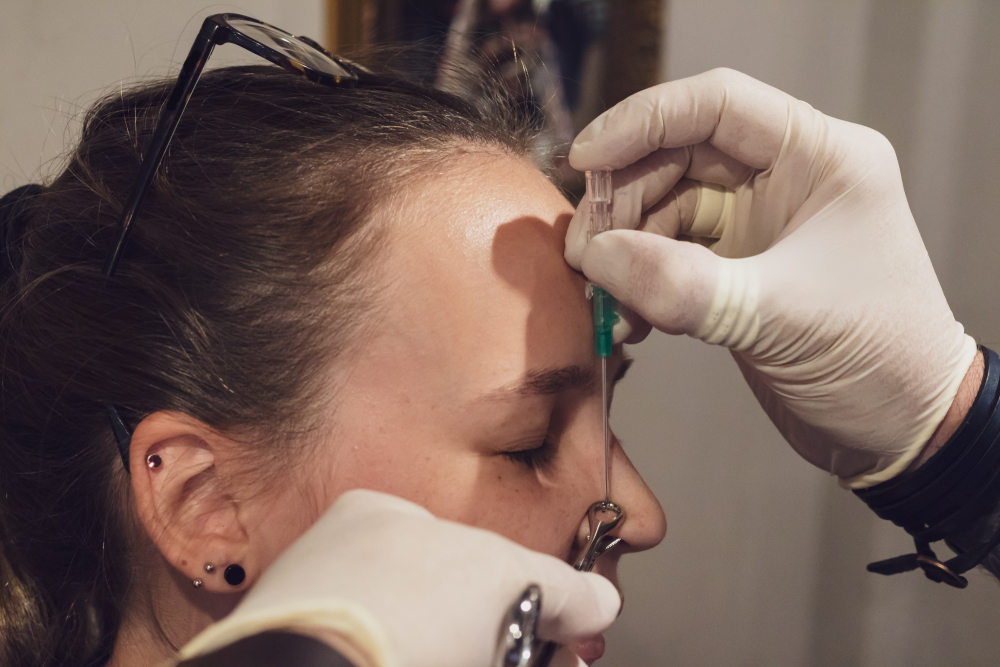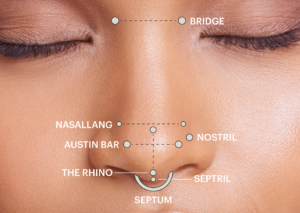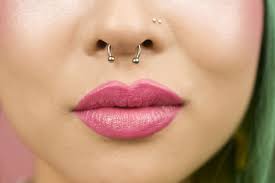How to Make a Nose Piercing Heal (Step-by-step )

The concept of How to make a nose piercing heal is very important, Although getting your nose pierced is a big commitment, it may be a terrific way to express yourself. If and when you decide to temporarily take off your piercing jewelry, you must exercise caution since nose piercings require continuing maintenance. Enough Info

How To Make A Nose Piercing Heal, It might take days, months, or even years for the piercing to shut if you choose to remove your jewelry permanently. But if you take good care of your nose piercing from the beginning, you’ll have a better chance of having it heal more rapidly.
Read Also; 22 Fast Home Remedies to Get Rid of a Cough
The majority of nose piercings recover between 2 to 9 months. The precise timeframe is determined by the piercing’s location, technique, jewelry choice, and how well you take care of the wound while it mends.
Health concerns and risk of nose piercings
While piercings might be stylish, there are hazards involved. Here are a few things to remember.
1. Infections
The germs that line your nose might cause an illness. Again, it’s crucial to adhere to a regular aftercare schedule. https://enoughinfo.com/how-to-make-a-nose-piercing-heal
2. Communicable diseases
Pay close attention to who pierces your nose and the tools they employ. Poorly sanitized equipment increases your risk of contracting hepatitis C or B, tetanus, and HIV.
3. Bleeding
If you have a medical condition that makes it difficult for your blood to clot, stay away from getting pierced. If you use anticoagulant medications, you should also discuss safety measures with your doctor.
4. Scarring
Symptoms of piercings frequently include hypertrophic scars. They often start to show around 4 to 8 weeks and gradually get smaller over time. You might still end up with a scar that is visible forever.
5. Keloids
Keloids, clumps of fibrous scar tissue that develop around wound sites, can be brought on by piercings. Keloids can occur at any age, however, those aged 10 to 30 experience them most frequently.
6. Nerve damage
A nasal piercing may cause a nerve to be impacted. This could occur more frequently if a novice piercer is utilized, especially if a piercing gun is employed. Permanent symptoms like numbness or a lack of feeling can result from nerve injury. https://enoughinfo.com/how-to-make-a-nose-piercing-heal
Read Also; How to do Crunches (Step-by-Step Guide 2023)

Part 1
How to Make a Nose Piercing Heal: Removing your nose jewelry
1. Wash your hands thoroughly before touching your nose jewelry
Use soap and water, wash your hands for at least 20 seconds, rinse well, then dry with a fresh towel. As a result, you have a far lower probability of spreading an infection to the piercing site.
- The best approach is washing with soap and water, however, hand sanitizer can also be used. Rub your hands together until the hand sanitizer is no longer damp. Apply a light layer of sanitizer to both of your hands.
- When you take off or tinker with any piercing jewelry, follow this cleaning procedure.
2. Take out the piece of jewelry carefully
Different types of piercing jewelry require different methods of removal. While some items of nose jewelry need the removal of backers that must be unscrewed or taken off, others may simply be pulled out. Whenever feasible, adhere to the removal instructions that the piercing specialist gave you.
- Because it might be more challenging to get your fingers in the appropriate place, nose piercing jewelry is sometimes more difficult to remove than earrings. Work gently and slowly.
3. Stop and contact a professional if you feel resistance during the removal
The healed skin around a nose piercing frequently holds the jewelry in place. In this situation, resist the urge to pull firmly to remove the jewelry. Instead, speak with a piercing expert—ideally the one who performed your nose piercing—or your physician, and ask them to take the jewelry out.
- By using force to pry out a trapped piece of nasal jewelry, you run the risk of damaging the piercing and expanding it. A bigger hole might never completely close or take longer to do so. Taking apart jewelry that is stuck up your chance of getting sick. How To Tell If You Have An Ear Infection
4. Wash the piercing gently with a mild cleaner
Use fresh water and a face cleanser devoid of scent, exfoliants, or other harsh ingredients. Use your finger or a cotton swab to gently rub the piercing in a circular motion on both sides. After gently patting it with a clean cloth, rinse the piercing with clean water. How To Stop Drinking Alcohol ( Step- by Step- Guide )
- Use cotton swabs to stop any small bleeding that occurs as you remove the jewelry, then carefully clean the area.
- Avoid attempting to push the cleaner into the piercing. Just concentrate on softly stroking it over the piercing’s surface on both sides.
Read Also; How To Stop Drinking Alcohol ( Step- by Step- Guide )

Part 2
How to Make a Nose Piercing Heal: Helping the piercing close
1. Allow anywhere from hours to years for the hole to close up
Unfortunately, it is impossible to know in advance how long a nose piercing will take to heal. In general, a piercing will heal more quickly the more recent it is. In fact, if you didn’t immediately insert jewelry into a brand-new nose piercing, it may seal up in as little as 10 minutes.
- A fresh nose piercing typically takes 6 to 12 months to heal completely around the jewelry. The hole will probably take several hours to several days to seal up if you decide to remove the jewelry during this time.
- It may take several days to a year or more for the hole to shut completely if you decide to permanently remove your nose jewelry once the piercing has fully healed around it. Sometimes, no matter how much time you give it, the hole just won’t shut.
2. Wash the area daily with a gentle skin cleanser
Repeat the cleaning process you used immediately after removing the jewelry once or twice every day. Don’t try to force the cleanser into the hole; rather, use your finger or a cotton swab to gently wipe both sides of the piercing. How to do Crunches (Step-by-Step Guide 2023)
- After taking off the jewelry, follow this regimen for at least a week; after that, continue it until the piercing hole has fully closed.
- Request cleanser suggestions from your dermatologist, primary care physician, and/or piercing expert.
3. Avoid using moisturizer, makeup, or similar products on the piercing
You can speed up the hole’s closure by preventing muck from amassing inside of it. As much as you can, keep everything away from the piercing while it heals, with the exception of clean water and your light face cleanser.
- Apply sunscreen to your nose with a cotton swab, paying special attention to the area immediately surrounding the piercing.
- The initial few days to weeks after taking off the jewelry are crucial for keeping debris out of the piercing hole, but it’s preferable to continue doing so for as long as the hole is still open.
4. Contact your doctor if you notice signs of a possible infection
It is possible, though unlikely, that you could get an infection there as the piercing closes. Do not ignore any infection-related symptoms; instead, call your doctor. The best way to prevent a more serious issue is to seek treatment right away.
- Redness, swelling, oozing, pain, and fever are typical indicators of infection.
- Depending on the kind of infection you have, your doctor may advise a topical antibiotic or other treatments.
5. Don’t stick things into the piercing to confirm that it has closed
When you attentively inspect the hole with a mirror, if it looks to be completely closed, you may presume that it is. Don’t give in to the urge to try it out! The fragile tissue that has just closed off the hole might be harmed or infected if the point of a piece of jewelry or a pin is inserted into the hole’s remnant.
- If you want proof that the hole has closed, ask your physician or piercing expert to examine you.
Part 3
How to Make a Nose Piercing Heal: Reduce scarring
1. Apply an anti-scar product daily, after the piercing has closed
You may find a variety of anti-scar creams, gels, and ointments on the market, so ask your dermatologist, primary care physician, or piercing specialist for advice. For the recommended amount of time, use the product as instructed. Be patient; it can take weeks, months, or even years to see the full effects.
- Unless expressly instructed to do so by your doctor, avoid using an anti-scar product while the piercing hole is still healing. How To Make a Gravity Bong ( Step by step)
2. Work with your doctor to manage a scar that won’t fade away
After taking an anti-scar product for three to six months, if you still don’t see benefits, talk to your doctor about your choices. They could advise you to try the product once again, move to a different product, or look into other options.
- A surgical or non-surgical scar removal method could be a viable choice in some circumstances. Get the procedure performed in this case by a licensed, experienced medical practitioner.
- Despite your best efforts, certain piercing holes may never entirely seal, and some piercing scars may never fully vanish. Before you had your nose pierced, your piercing expert should have hopefully explained this message to you.
Read Also; How To Make a Gravity Bong ( Step by step)
3. Don’t pierce the exact same spot in the future
Don’t try to re-pierce the old hole if you change your mind and decide to get your nose pierced once more. It is usually preferable to have a new piercing in a different place since the scar tissue inside the piercing hole is thinner and more prone to infection than the surrounding skin.
- Find out how close to your current nose piercing you may receive a new one by speaking with a piercing expert. Most of the time, you may receive a new piercing in a fairly identical location, albeit not exactly.
What are the different stages of nose piercing healing?
The healing process after a piercing comprises four primary phases.
Hemostasis:
Your piercing should stop bleeding and begin to scab within the first 24 hours.
Inflammatory:
24 to 48 hours after the piercing, this stage reaches its peak. Your body will draw immune cells to the wound, which will also get rid of bacteria.Normal little swell or discomfort
Proliferation:
Between 4 and 24 days make up this phase. Your wound will become dry and crusted. New blood vessels are formed, and tissue fills the wound.
Maturation:
The new tissues that formed during the proliferation phase become stronger during this phase. The length of maturation can range from 21 days to 2 years.
Read Also; How To Make Quesadilla ( Step by Step Methods)
conclusion.
At first, you might have some bleeding, bruising, swelling, or soreness. For up to three weeks, it could be red, sensitive, and inflamed. Nostril piercings recover fully in two to four months. A septum piercing heals in three to four months.




